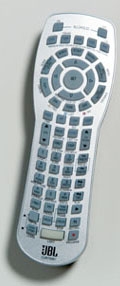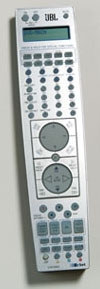JBL Cinema Vision Home Theater System Page 2
Once I got past the steep learning curve required to work the system, I quickly appreciated the level of integration it offered. At minimum, it was nice to have one remote control sitting on my table rather than my usual five. I found it easy to use the remotes to operate my VCR and to control virtually all of the functions of my high-def cable box/DVR. A cool feature of the system is an infrared (IR) sensor built into the TV's frame that relays commands to the receiver/player. This lets you install the electronics out of the way in a closet and control the entire system by simply pointing the remote at the screen. Very cool!

With up to five discs hidden in the built-in changer's trays, you might very well lose track of what's there. The system's On-screen Library feature will be of use here. Pressing the OSL button on either remote calls up a screen showing each DVD's title and, with some discs, an accompanying image. A number of CDs also contain text and image info that can be extracted for use with the JBL's On-screen Library. When you're watching DVDs, the receiver/player's video section delivers an upconverted digital signal that matches the TV's native 1,366 x 768-pixel resolution. And then there are the audio modes, which include Dolby Digital EX, DTS-ES, Dolby Pro Logic II and IIx, and JBL's proprietary Logic 7.
Although each of the Cinema Vision's audio and video settings can be fully customized by tweaky types - including parameters like individual speaker levels and picture settings that can be adjusted on the fly without entering menus - average folks will mostly appreciate the system's Auto-setting functions. Here's an example of them in action: You tune in a program like Jeopardy that has a standard 4:3 picture and stereo sound. The image automatically fills the TV's entire 16:9 screen via a combination of stretch and zoom techniques, and the receiver kicks into Dolby Pro Logic II Movie mode to spread the sound around to all the system's speakers. And when you later tune in an HDTV program like Monday Night Football, the picture is displayed in regular 16:9 widescreen mode and the sound defaults to 5.1-channel Dolby Digital. Easy as pie.

MUSIC PERFORMANCE Logic 7 processing proved to be the way to go for all kinds of music. I'd recommend just setting it as the default mode for the system and leaving it there. Logic 7 turned stereo recordings - like Kraftwerk's new Minimum-Maximum electro-pop CD - into a near-discrete 5.1-channel listening experience, with crowd ambience creeping through the surround speakers to dramatically enhance the disc's live performances. Dynamics were, to say the least, impressive: the system's slamming rendition of electronic bass lines in the track "Numbers" had an almost physical dimension.
Staying with electronic music, I cued up "Tha" from Aphex Twin's Selected Ambient Works 85-92, a techno CD. Logic 7 retained the song's focus by locking the glitchy beats dead center while distributing the spacious synth pads and searing leads evenly from the front to the rear speakers. I was surprised at how warm analog synths sounded, given that JBL uses digital amplifiers to power the speakers. Digital amps have a reputation for delivering too crisp or "etched" a signature. While the sound did lean slightly to the bright side, its main quality was one of clarity as opposed to a harsh, in-your-face character.
MOVIE PERFORMANCE Watching Man on Fire on DVD gave me a good chance to experience the movie's potent 5.1-channel soundtrack and the JBL system's explosive dynamics. In a scene where the bodyguard Creasy (Denzel Washington) waits for his soon-to-be-kidnapped rich-girl charge to finish a piano lesson, gentle strains of Debussy drift out from a window and are joined by the whizzing sounds of predatory cars circling the building. Once Creasy cops to what is happening, strong bass rumbles heighten the air of menace. The scene ultimately erupts in a full-out gun battle after the child emerges from the building. The system reproduced each sonic layer with almost surgical accuracy, cleanly delivering both the full ambience of the gun's report as well as the bullet's directional trajectory.




























































